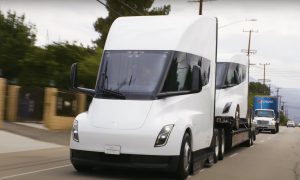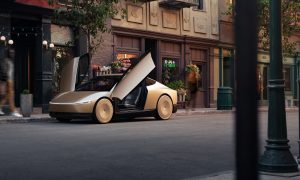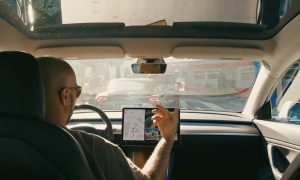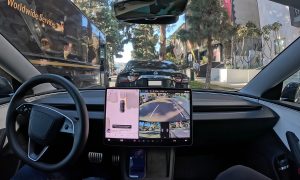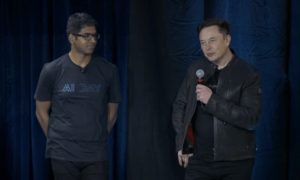News
Intel CEO believes autonomous driving data is the new oil
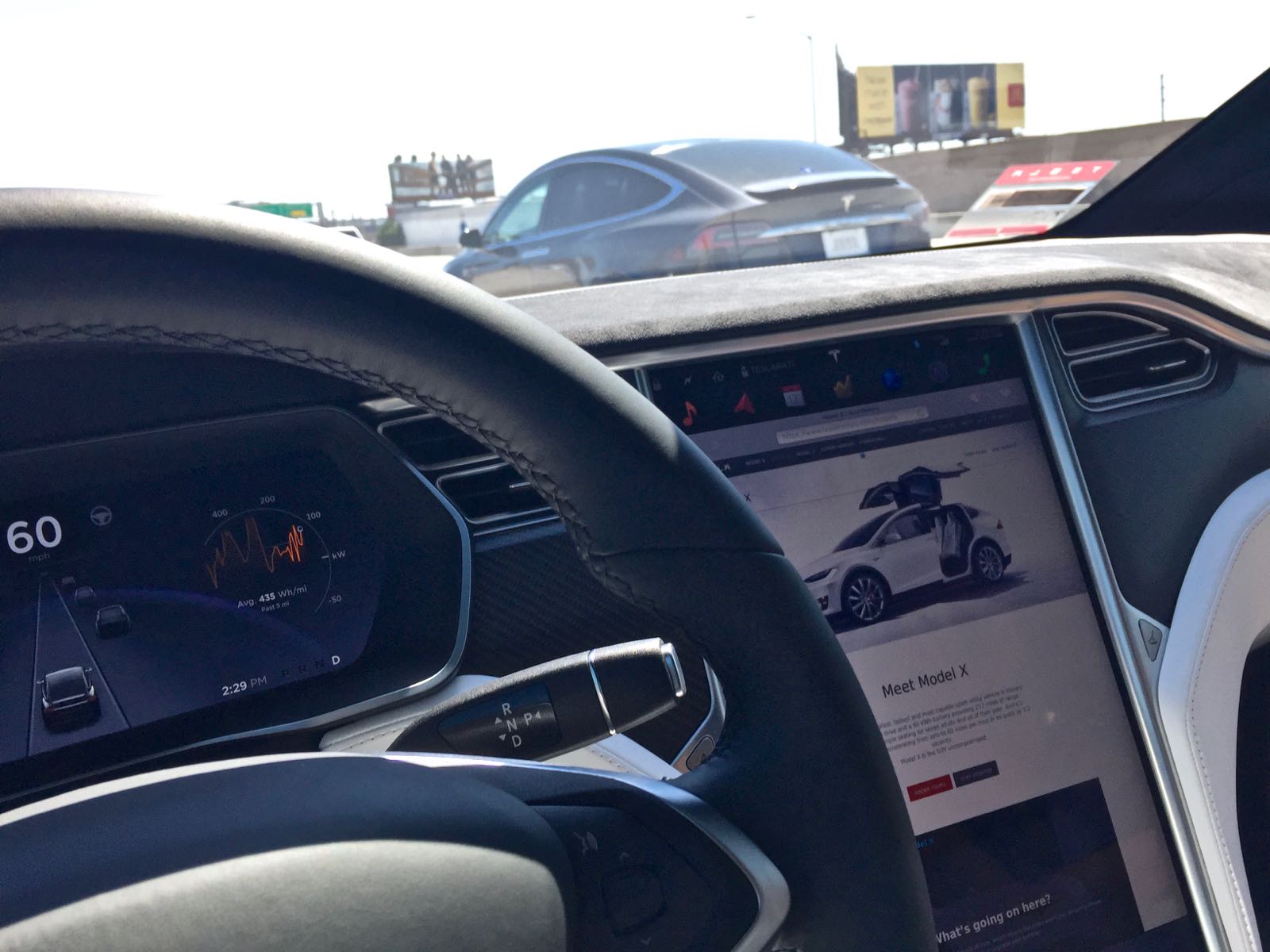
The LA Auto Show may be remembered more for its technologies than the actual cars it showcased. That’s because automakers and technology companies are no longer isolated; instead, they’re part of a new and fascinating picture in which, when it comes to the future of automobiles, “data is the new oil.”
Intel CEO Brian Krzanich, delivering a keynote address at the Automobility LA conference (as part of the LA Auto Show) on Nov. 15, described the confluence of automobiles, data dependence, and connectivity as being equally valuable as an integrated whole as automobiles currently are on oil. Krzanich stated,
“We are in a time when technology is valued not just for the devices it produces, but for the experiences it makes possible. Data has the potential to radically change the way we think about the driving experience: as consumers, as automakers, as technologists, and as citizens of our communities,”
Intel’s interest in self-driving vehicles has grown over the last year after acquiring machine vision company, Itseez, Inc. this past May. With Itseez in its portfolio, Intel is developing algorithms and implementations of computer vision around automobiles, among other applications. Additionally, a partnership with BMW and system-on-a-chip maker and ex-Tesla partner Mobileye may produce an open platform for designing autonomous vehicles.
“It’s not enough just to capture the data,” Krzanich argued. “We have to turn the data into an actionable set of insights to get the full value out of it. To do that requires an end-to-end computing solution from the car through the network and to the cloud — and strong connectivity.”
Krzanich’ keynote speech marks the first time that Intel, the semiconductor conglomerate, has ever had a prominent role at an automobile show. It follows an editorial that he wrote earlier in the year in which he outlined five key points to accelerate Intel’s transformation from a PC company to a company that powers the cloud and billions of smart, connected computing devices. According to Krzanich:
- The cloud is the most important trend shaping the future of the smart, connected world. Virtualization and software are increasingly defining infrastructure in the cloud and data center.
- The many “things” that make up the PC Client business and the Internet of Things are made much more valuable by their connection to the cloud. The Internet of Things encompasses all smart devices – every device, sensor, console and any other client device – that are connected to the cloud. Everything that a “thing” does can be captured as a piece of data, measured real-time, and is accessible from anywhere. The biggest opportunity in the Internet of Things is its ubiquity.
- Memory and programmable solutions such as FPGAs, which are integrated circuits that can be programmed in the field after manufacture, will deliver entirely new classes of products for the data center and the Internet of Things. Breakthrough innovations and products to the cloud and data center infrastructure are revolutionizing the performance and architecture of the data center, with growth for years to come.
- 5G will become the key technology for access to the cloud, providing computing power to a device and connecting it to the cloud makes it more valuable. The example of the autonomous vehicle, with its need for connectivity to the cloud alongside the cloud’s need for machine learning capabilities, requires the most up-to-date algorithms and data sets to allow the vehicle to operate safely. In this way, connectivity is fundamental to every one of the cloud-to-thing segments we will drive.
- Moore’s Law, in which Intel co-founder Gordon Moore in 1965 noticed that the number of transistors per square inch on integrated circuits had doubled every year since their invention, will continue. This concept has fueled the recent technology revolution.
Krzanich elaborated at the Automobility LA conference that autonomous cars may soon utilize sensors from LIDAR, sonar, and radar, as well as GPS and cameras. A single autonomous vehicle could generate approximately 4 terabytes (4,000 GB) of data daily. “Every autonomous car will generate the data equivalent of almost 3,000 people. Extrapolate this further and think about how many cars are on the road. Let’s estimate just 1 million autonomous cars worldwide — that means automated driving will be representative of the data of 3 billion people,” Krzanich said.
The keynote speech augmented an Intel press statement that its Capital division will invest $250 million over the next two years into developing technologies around autonomous vehicles, which are “areas where technology can directly mitigate risks while improving safety, mobility, and efficiency at a reduced cost; and companies that harness the value of the data to improve reliability of automated driving systems.”
Source: Brian Krzanich Editorial
Elon Musk
Tesla reveals it is using AI to make factories more sustainable: here’s how
Tesla is using AI in its Gigafactory Nevada factory to improve HVAC efficiency.

Tesla has revealed in its Extended Impact Report for 2024 that it is using Artificial Intelligence (AI) to enable its factories to be more sustainable. One example it used was its achievement of managing “the majority of the HVAC infrastructure at Gigafactory Nevada is now AI-controlled” last year.
In a commitment to becoming more efficient and making its production as eco-friendly as possible, Tesla has been working for years to find solutions to reduce energy consumption in its factories.
For example, in 2023, Tesla implemented optimization controls in the plastics and paint shops located at Gigafactory Texas, which increased the efficiency of natural gas consumption. Tesla plans to phase out natural gas use across its factories eventually, but for now, it prioritizes work to reduce emissions from that energy source specifically.
It also uses Hygrometric Control Logic for Air Handling Units at Giafactory Berlin, resulting in 17,000 MWh in energy savings each year. At Gigafactory Nevada, Tesla saves 9.5 GWh of energy through the use of N-Methylpyrrolidone refineries when extracting critical raw material.
Perhaps the most interesting way Tesla is conserving energy is through the use of AI at Gigafactory Nevada, as it describes its use of AI to reduce energy demand:
“In 2023, AI Control for HVAC was expanded from Nevada and Texas to now include our Berlin-Brandenburg and Fremont factories. AI Control policy enables HVAC systems within each factory to work together to process sensor data, model factory dynamics, and apply control actions that safely minimize the energy required to support production. In 2024, this system achieved two milestones: the majority of HVAC infrastructure at Gigafactory Nevada is now AI-controlled, reducing fan and thermal energy demand; and the AI algorithm was extended to manage entire chiller plants, creating a closed-loop control system that optimizes both chilled water consumption and the energy required for its generation, all while maintaining factory conditions.”
Tesla utilizes AI Control “primarily on systems that heat or cool critical factory production spaces and equipment.” AI Control communicates with the preexisting standard control logic of each system, and any issues can be resolved by quickly reverting back to standard control. There were none in 2024.
Tesla says that it is utilizing AI to drive impact at its factories, and it has proven to be a valuable tool in reducing energy consumption at one of its facilities.
Elon Musk
Tesla analysts believe Musk and Trump feud will pass
Tesla CEO Elon Musk and U.S. President Donald Trump’s feud shall pass, several bulls say.

Tesla analysts are breaking down the current feud between CEO Elon Musk and U.S. President Donald Trump, as the two continue to disagree on the “Big Beautiful Bill” and its impact on the country’s national debt.
Musk, who headed the Department of Government Efficiency (DOGE) under the Trump Administration, left his post in May. Soon thereafter, he and President Trump entered a very public and verbal disagreement, where things turned sour. They reconciled to an extent, and things seemed to be in the past.
However, the second disagreement between the two started on Monday, as Musk continued to push back on the “Big Beautiful Bill” that the Trump administration is attempting to sign into law. It would, by Musk’s estimation, increase spending and reverse the work DOGE did to trim the deficit.
Every member of Congress who campaigned on reducing government spending and then immediately voted for the biggest debt increase in history should hang their head in shame!
And they will lose their primary next year if it is the last thing I do on this Earth.
— Elon Musk (@elonmusk) June 30, 2025
President Trump has hinted that DOGE could be “the monster” that “eats Elon,” threatening to end the subsidies that SpaceX and Tesla receive. Musk has not been opposed to ending government subsidies for companies, including his own, as long as they are all abolished.
How Tesla could benefit from the ‘Big Beautiful Bill’ that axes EV subsidies
Despite this contentious back-and-forth between the two, analysts are sharing their opinions now, and a few of the more bullish Tesla observers are convinced that this feud will pass, Trump and Musk will resolve their differences as they have before, and things will return to normal.
ARK Invest’s Cathie Wood said this morning that the feud between Musk and Trump is another example of “this too shall pass:”
BREAKING: CATHIE WOOD SAYS — ELON AND TRUMP FEUD “WILL PASS” 👀 $TSLA
She remains bullish ! pic.twitter.com/w5rW2gfCkx
— TheSonOfWalkley (@TheSonOfWalkley) July 1, 2025
Additionally, Wedbush’s Dan Ives, in a note to investors this morning, said that the situation “will settle:”
“We believe this situation will settle and at the end of the day Musk needs Trump and Trump needs Musk given the AI Arms Race going on between the US and China. The jabs between Musk and Trump will continue as the Budget rolls through Congress but Tesla investors want Musk to focus on driving Tesla and stop this political angle…which has turned into a life of its own in a roller coaster ride since the November elections.”
Tesla shares are down about 5 percent at 3:10 p.m. on the East Coast.
Elon Musk
Tesla scrambles after Musk sidekick exit, CEO takes over sales
Tesla CEO Elon Musk is reportedly overseeing sales in North America and Europe, Bloomberg reports.

Tesla scrambled its executives around following the exit of CEO Elon Musk’s sidekick last week, Omead Afshar. Afshar was relieved of his duties as Head of Sales for both North America and Europe.
Bloomberg is reporting that Musk is now overseeing both regions for sales, according to sources familiar with the matter. Afshar left the company last week, likely due to slow sales in both markets, ending a seven-year term with the electric automaker.
Tesla’s Omead Afshar, known as Elon Musk’s right-hand man, leaves company: reports
Afshar was promoted to the role late last year as Musk was becoming more involved in the road to the White House with President Donald Trump.
Afshar, whose LinkedIn account stated he was working within the “Office of the CEO,” was known as Musk’s right-hand man for years.
Additionally, Tom Zhu, currently the Senior Vice President of Automotive at Tesla, will oversee sales in Asia, according to the report.
It is a scramble by Tesla to get the company’s proven executives over the pain points the automaker has found halfway through the year. Sales are looking to be close to the 1.8 million vehicles the company delivered in both of the past two years.
Tesla is pivoting to pay more attention to the struggling automotive sales that it has felt over the past six months. Although it is still performing well and is the best-selling EV maker by a long way, it is struggling to find growth despite redesigning its vehicles and launching new tech and improvements within them.
The company is also looking to focus more on its deployment of autonomous tech, especially as it recently launched its Robotaxi platform in Austin just over a week ago.
However, while this is the long-term catalyst for Tesla, sales still need some work, and it appears the company’s strategy is to put its biggest guns on its biggest problems.
-

 Elon Musk1 day ago
Elon Musk1 day agoTesla investors will be shocked by Jim Cramer’s latest assessment
-

 News6 days ago
News6 days agoTesla Robotaxi’s biggest challenge seems to be this one thing
-

 News2 weeks ago
News2 weeks agoTesla’s Grok integration will be more realistic with this cool feature
-

 Elon Musk2 weeks ago
Elon Musk2 weeks agoElon Musk slams Bloomberg’s shocking xAI cash burn claims
-

 News2 weeks ago
News2 weeks agoTesla China roars back with highest vehicle registrations this Q2 so far
-

 News2 weeks ago
News2 weeks agoTexas lawmakers urge Tesla to delay Austin robotaxi launch to September
-

 News2 weeks ago
News2 weeks agoTesla dominates Cars.com’s Made in America Index with clean sweep
-

 Elon Musk1 week ago
Elon Musk1 week agoFirst Look at Tesla’s Robotaxi App: features, design, and more


